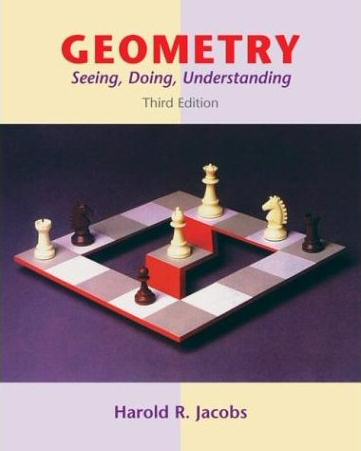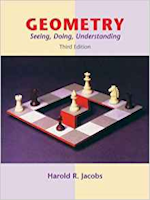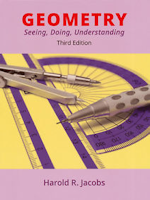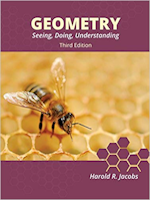|
|
Geometry

|
|
|
Description
This course will cover the topics normally covered in a high school geometry course. This course is normally taken by students in grade nine or ten. Students should have completed Algebra 1 before enrolling in Geometry. A detailed course outline is shown below.
|
Lecture Notes and Class Time
Class time will primarily be spent on instruction. Students should bring their Student Workbook to each class, or a printout of the pages for that week. The pages of the workbook are identical to the instructor's lecture notes, except the student version has the solutions and answers deleted. During the lecture the students take notes and solve the example problems in the workbook.
Videos of the lectures are also available online, and these videos go through the same lecture notes, point by point. Students use the videos to cover any material that time constraints did not permit us to cover in our weekly class. Or, if a student misses a class or needs to review the material, all of the course content is available online. It is possible to take the entire course online via distance learning, and many students have done so.
|
Textbook
Geometry: Seeing, Doing, Understanding by Harold R. Jacobs, 3rd Edition,
published by W. H. Freeman, 2003. This is an extremely readable and engaging
math textbook. The text emphasizes Euclidean geometry and explains the importance
of logical reasoning and proof in mathematics. It has numerous practical and
interesting examples and shows the many applications of geometry in the real world.
It also touches on some important topics in analytic geometry (geometry in the
coordinate plane), a topic that is essential for much further study in mathematics.
We use the third edition of this text. There are three different
printings
of the third
edition, all
shown below. Any of these will do. Copies are also usually available to borrow
upon request.

ISBN-13: 978-0716743613
ISBN-10: 0716743612
|

ISBN-13: 978-1619991095
ISBN-10: 1619991098
|

ISBN-13: 978-1683440208
ISBN-10: 168344020X
|
|
Homework, Tests and Grades
Students will be given specific assignments to do on their own each week. Assignments will consist of additional lectures delivered on the computer, problems to practice, and homework assignments that will be collected and graded. To allow for the maximum amount of instructional time in class, tests will be given at home. One final exam for each semester will be taken in class at the end of the semester. Students will receive a numerical grade for each semester and for the year. The grade is calculated based on tests, graded homework and the final exams.
|
Difficulty Level
The question is often raised, "When should a student take Geometry?" Geometry is somewhat different
from the other high school math courses. The main sequence of algebra courses is typically, in order:
Prealgebra -> Algebra 1 -> Algebra 2 -> Precalculus. Geometry, while certainly related, is somewhat
unique, and can be considered separately from the sequence of algebraic math courses. Most schools
place Geometry between Algebra 1 and Algebra 2 simply because it is generally a bit harder than
Algebra 1 but not as difficult as Algebra 2. This particular course is designed to be taken after
Algebra 1. The course assumes that the students know basic algebra, and it also incorporates an
Algebra Review lesson in most chapters so students don't lose touch with their Algebra skills during
a year in Geometry. Although most students take one math class at a time, some students have taken
this course concurrently with Algebra 2.
Not all students require the same pace and difficulty level. Some may need or prefer a class that is
more challenging and at a faster pace, while some may desire a class that is not accelerated. This
class is offered simultaneously on two difficulty levels, regular and honors. The lectures are the
same for both. The honors students will have additional homework problems that are more difficult,
and on each test will have an extra page with more challenging questions. Note that the honors class
is not an AP class. It is simply a more challenging version of the same course. The goal is for the
classes to closely correspond to "Regular Geometry" and "Honors Geometry" classes at a good private
school. Students may decide whether they will take the regular or honors version of the course after
completing one or two chapters.
|
Internet Access
Access to a computer with a high speed internet connection is strongly recommended, and is required for distance learning. Instructional materials such as lecture videos, lecture notes, homework assignments and tests will be available over the internet. Graded assignments and tests may also be returned via email in order to provide more timely feedback. Progress reports will be put on the website and updated regularly.
|
The Instructor
Derek Owens graduated from Duke University in 1988 with a degree in mechanical engineering and
physics. He taught physics, honors physics, AP Physics, and AP computer science at The Westminster Schools
in Atlanta, GA from 1988-2000. He worked at the TIP program at Duke for two years, teaching physics and
heading the Satellite Science Program. He received a National Science Foundation scholarship and
studied history and philosophy of science at L'Abri Fellowship in England. He worked as a software
developer for six years before returning to teaching. Since 2006, he has been a full time teacher for
homeschoolers in the Atlanta area. He and his wife Amor and their two children Claire and David
attend Dunwoody Community Church, a non-denominational church near their home in Norcross, GA.
|
Course Outline
These topics comprise the material normally taught in a high school Geometry course.
-
Chapter 1: Introduction to Geometry
Lines, Angles, Polygons, Polyhedra, Constructions
-
Chapter 2: Deductive Reasoning
Conditional Statements, Definitions, Direct and Indirect Proof, Geometry as a Deductive System, Famous Geometry Theorems
-
Chapter 3: Lines and Angles
Number Operations from Algebra, Rulers and Distance, Protractors and Angles, Bisection, Complementary and Supplementary Angles, Linear Pairs, Vertical Angles, Perpendicular Lines, Parallel Lines
-
Chapter 4: Congruence
Coordinates and Distance, Congruent Polygons, ASA Congruence, SAS Congruence, Proofs involving Congruence, Isosceles Triangles, Equilateral Trianges, SSS Congruence, Constructions
-
Chapter 5: Inequalities
Properties of Inequality, The Exterior Angle Theorem, Triangle Side and Angle Inequalities, The Triangle Inequality Theorem
-
Chapter 6: Parallel Lines
Line Symmetry, Parallel Lines, The Parallel Postulate, Angles formed by Parallel Lines, The Angles of a Triangle, AAS Congruence, HL Congruence
-
Chapter 7: Quadrilaterals
Quadrilaterals, Parallelograms, Point Symmetry, Rectangles, Rhombuses, Squares, Trapezoids, The Midsegment Theorem
-
Chapter 8: Transformations
Transformations, Reflections, Isometries, Congruence, Symmetry
-
Chapter 9: Area
Areas of Squares and Rectangles, Areas of Triangles, Parallelograms and Trapezoids, The Pythagorean Theorem
-
Chapter 10: Similarity
Ratios and Proportions, Similar Figures, the Side-Splitter Theorem, AA Similarity, Dilations, Perimeters and Areas of Similar Figures
-
Chapter 11: Right Triangles
Proportions in Right Triangles, The Pythagorean Theorem, Isosceles Right Triangles, 30-60-90 Triangles, The Tangent Ratio, Sine and Cosine, Slope, The Law of Sines, The Law of Cosines
-
Chapter 12: Circles
Circles, Radii, Chords, Tangents, Central Angles, Arcs, Inscribed Angles, Secant Angles, Tangent Segments, Intersecting Chords
-
Chapter 13: The Concurrence Theorems
Triangles and Circles, Cyclic Quadrilaterals, Incircles, The Centroid, Ceva's Theorem, Napoleon's Discovery
-
Chapter 14: Regular Polygons and the Circle
Regular Polygons, Perimeter and Area of Regular Polygons, Polygons and Pi, The Area of a Circle, Sectors and Arcs
-
Chapter 15: Geometric Solids
Lines and Planes in Space, Solid Geometry, Rectangular Solids, Prisms, The Volume of a Prism, Pyramids, Cylinders and Cones, Spheres, Similar Solids, The Regular Polyhedra
|
|
|
|
